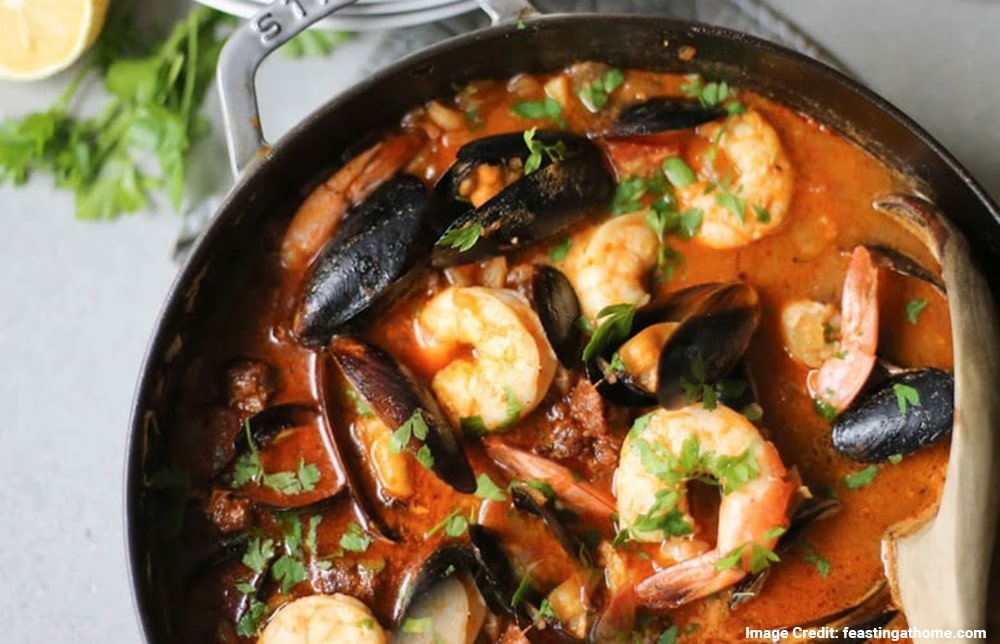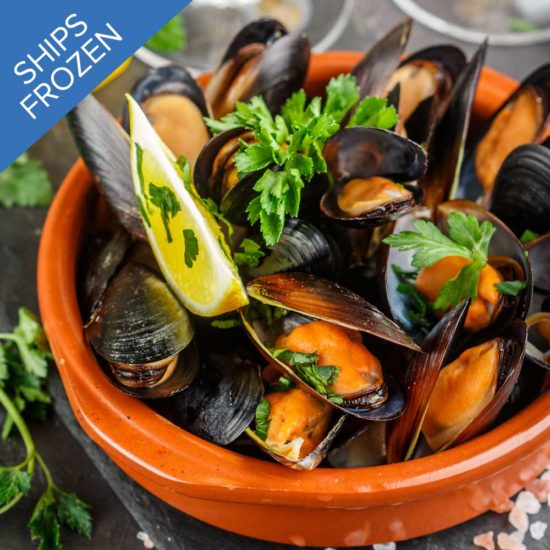
Stews for You!
![]()
The weather is quite chilly, snow’s been predicted in the forecast. And all I’m craving is something hot, deliciously simmered and comforting enough to keep me cozy…Let’s talk about stews!
These cravings always creep in during this time of year, the depths of winter, when I want the most comfort-food-thing possible. I turn to stews. I’m a super fan…a super stew fan.
Here we’ll discuss the building blocks of making a great stew from scratch. The ingredients needed, flavor boosting elements, the perfect seafood for simmering and key facts for optimum stew-age.
Top Stew Facts:
What Ingredients Need to be in a Stew to make it a Stew?
There are really just 3 categories of ‘food-stuffs’ that make a stew: vegetables, seafood (or meat) and a liquid. I’ll give you all the key ingredients, plus a few fun additions, that’ll make every stew shine, a little later.
There aren’t really any firm rules for stew. Unlike a bisque or a chowder that need specific ingredients in order to call them by name, seafood stew recipes can be ad-libbed and creative.
What’s the Difference Between a Stew and a Soup?
Simply put, it’s the amount of liquid that sets these two apart. A soup contains more liquid than a stew. For a stew you just want to barely cover the vegetables and seafood with a liquid (and we’ll go into liquid options a little later on). As the stew simmers, the vegetables and the seafood gently cook and the liquid thickens. Giving stews their tell-tale gravy like consistency.
What Do I Serve with Stew?
Probably one of my favorite things about stews is their compatibility with side dishes! Stews can be served solo or spooned over rice, mashed potatoes, buttered noodles, bread (a little trencher), couscous…you name it!
Key Ingredients:
These are the stewing basics, the must haves for making a seafood stew recipe.
Fat – All good stews need a little fat. This can be an oil (olive oil, avocado oil, coconut oil…) or butter. Fat helps transfer the heat, softening vegetables and moisturizing proteins. Since stews are cooked slowly (lower heat) over time the type of oil or butter used can be anything. The risk of burning or degrading is drastically reduced.
Mirepoix – Mirepoix is the fancy French culinary term for the holy trinity of vegetables: carrots, celery and onion. These three are the flavor building blocks of any good stew. The start of any stew is by sautéing the mirepoix in your chosen fat.
Broth or Stock – You need a flavorful liquid to simmer your ingredients. Broths and stocks are perfect. For seafood based stews, use a neutral vegetable broth or stock if a seafood option is not available. The liquid is added after the mirepoix has been sautéed. Once the broth or stock begins to simmer then our seafood ingredients are added.
Seasoning – All good stews need a little enhancement, but it does not need to be complicated. A little salt and pepper go a long way! Season your stews right before you serve. Since these flavors concentrate over time, you don’t want to risk over seasoning in the beginning.
Best Seafood for Stewing:
My all time favorite stews are seafood based. A good Maryland girl with a love of seafood! Here are the best seafood options for stewing: fresh clams, mussels, lobster and shrimp. Fish is fabulous as well, try cod, salmon, swordfish, mahi mahi or rockfish. Since we’re cooking at a reasonable simmering temperature (180°-190°F), the seafood doesn’t run the risk of overcooking or breaking apart. I do recommend portioning the pieces into large, even bite-sized chunks. This will allow for even cooking.
Fun Adds:
You don’t just have to stop at the key ingredients and the seafood! The fun thing with stews is their customization. Here are a handful of my fun and flavorful stew additions!
Cream. Adding a touch, splash or glug of cream will give your stew added silky richness. Stir cream, milk, sour cream, etc… towards the end of your simmer.
Wine A classic stew favorite. Red or white, it’s all good (just remember that red wine will stain your seafood slightly). Add a splash of wine while sautéing your mirepoix, this will give the alcohol enough time to mellow.
Beer & Bourbon – Why stop at wine?! Beer and whiskey are great ‘secret’ ingredients for stews. Same rule applies as the wine, a little splash while sautéing.
Tomato – Classic as classic can be, tomato based stews. This can be a little tomato paste, canned crushed tomatoes or tomato juice whisked in with the broth.
Additional Seasoning – Salt and pepper are key but that shouldn’t be limiting. I love adding garlic, fennel, crushed red pepper flakes, Old Bay Seasoning or smoked paprika to my stews. Feel free to get creative with your seasoning!
Buy Seafood Online-and cook good food at home!
There are oodles of seafood options available at our online store. As we say, ‘from shore to door, 3 days fresher than the grocery store’-all of our seafood is delivered right to your door when you schedule it, guaranteed! That’s convenience you need, especially for planning your next stew!
We’d love to see your Cameron’s Seafood stews-share your images on any of our social pages, Instagram, Facebook or Twitter be sure to tag us @cameronss

About the author
Patterson Watkins is a professional chef with over 17 years of experience. With a robust career in restaurants, contract dining and catering (including 4 Summer Olympic posts preparing food for the athletes!) Patterson joined the Cameron’s Seafood team at the end of 2018 to concoct some delicious recipes with our premium seafood items as the centerpiece.






